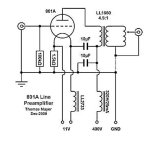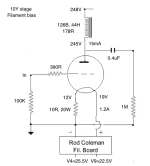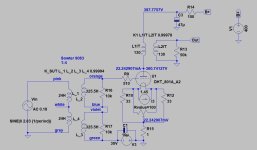Your designs typically use filament bias in order to eliminate the bypass cap. Is there some reason why filament bias can't be used here?Just got this up and running - 10Y into LL1660, Alt T in 4.5:2. Sounds nice. Any suggestions? I could increase the current.....
View attachment 1338415
Not all methods of battery grid bias require the use of a blocking cap on the input. If you put the battery in series with the incoming signal, no cap is needed. That's how I normally do it. It does require you to use a separate battery for each input tube. The other method, which requires blocking caps, allows you to bias both tubes with a single battery.Simple and easy! No DC blocking cap at input?
https://www.tubecad.com/2014/11/blog0313.htm
1660 in Alt T (2:4.5) has only 33H primary inductance and the maximized primary current is 20mA (for 0.9T excitation).Just got this up and running - 10Y into LL1660, Alt T in 4.5:2.
If you use the IT reversed, the suggested current would be lower, below 10mA (see Alt S 4:4.5 with 10mA).
When I tried 801a with choke/IT, the minimal inductance -for good LF behaviour- was over 80H, mainly 100-130H, at 25-30mA.
Hello Bela. I'm using LL1660/18mA in Alt T reversed, so 4.5:2. The inductance for 4.5:1 for this 18mA transformer in Alt Q is 100H. In Alt T reversed the primary winding looks the same, just with the coils the other way around. So wouldn't the primary in Alt T reversed be less than but closer to 100H?
Thomas Mayer used this transformer in Alt Q, 4.5:1. He was putting 7.3mA through the 801A if there was 11V on the cathode so presumably he was using the 10mA version. Does that sound correct or not? Not sure how to read the filament supply with the choke.
https://www.lundahltransformers.com/wp-content/uploads/datasheets/1660.pdf

Thomas Mayer used this transformer in Alt Q, 4.5:1. He was putting 7.3mA through the 801A if there was 11V on the cathode so presumably he was using the 10mA version. Does that sound correct or not? Not sure how to read the filament supply with the choke.
https://www.lundahltransformers.com/wp-content/uploads/datasheets/1660.pdf

Last edited:
Thomas use 18mA version, because this solution is simple cathode bias (1k5 cathode resistor).
I simulated it at the time.

Case of 4.5:1 Alt Q the (4.5) primary is series connected C (13,16, n turn) and C (18, 21, n turn) coils. The secondary is paralleled the all "small" (A, B, A, B) coils.
The excitation of core due to the 2n turn and anode current.
At the 2:4.5 Alt T the primary is series connected A and B coils paralleled with another series connected A and B.
Its turn value little lower, than half of secondary (series connected C coils).
If its recommended current is 20mA, if you reverse the IT, the theoretically assumed current: 20mA/2.25= 8.89mA
But it's the same series connected C-C, so if Alt Q case the 16mA is allowed, in case reversed Alt T also has to be good.
p.s. I'm not a fan of "universal" transformers.
Lundahl make good transformers, better than this. Every time I tried it, I always get rid of it afterwards.
p.s 2:
Alt Q connection maximum recommended source impedance is 3k.
I simulated it at the time.

Case of 4.5:1 Alt Q the (4.5) primary is series connected C (13,16, n turn) and C (18, 21, n turn) coils. The secondary is paralleled the all "small" (A, B, A, B) coils.
The excitation of core due to the 2n turn and anode current.
At the 2:4.5 Alt T the primary is series connected A and B coils paralleled with another series connected A and B.
Its turn value little lower, than half of secondary (series connected C coils).
If its recommended current is 20mA, if you reverse the IT, the theoretically assumed current: 20mA/2.25= 8.89mA
But it's the same series connected C-C, so if Alt Q case the 16mA is allowed, in case reversed Alt T also has to be good.
p.s. I'm not a fan of "universal" transformers.
Lundahl make good transformers, better than this. Every time I tried it, I always get rid of it afterwards.
p.s 2:
Alt Q connection maximum recommended source impedance is 3k.
Last edited:
I'm not a great fan of Lundahl transformers, one reason being that the connecting pins revolve and break the connection with the coil. I had to re-solder one of my transformers and another couldn't be saved. They should have fixed that by now. But Hammond don't have a very interesting range so no obvious alternatives except maybe Sowter. Don't know their range.
I rarely use transformers in preamps or driver stages - I like cap coupling. Usually with FT-3 caps but I have 1uF KBG PIOs which sound excellent too.
I rarely use transformers in preamps or driver stages - I like cap coupling. Usually with FT-3 caps but I have 1uF KBG PIOs which sound excellent too.
I'm obviously not real familiar with filament bias but now I see that the resistor also needs to dissipate the filament current so that makes it impractical to use with the 10.Any suggestions? I could increase the current.....
I'd still suggest battery grid bias if you want to eliminate the bypass cap and run a bit more current. Get a battery holder that accommodates a pair of AA batteries for each channel. Use a pair of "6v dog collar" batteries in one side. They're half the length of an AA. Then use an AA in the other side. Total voltage will be a little under 14v. Or a single AA holder with the dog collar batteries will give you around 12.3v or so.
I've just sold my 10Y preamp and having listened to it for a couple of days I'm now left wanting a replacement. I've been pretty happy with my 6C4C stage but the 10Y has more tone and inner detail.
I'll use resistor load or maybe a Hammond 126B since I have a pair, but just as a plate choke, and then cap couple. I think I'll probably use filament bias, that's what I used to do a couple of years ago. Not too difficult with a 10Y. Probably something like this below....

I'll use resistor load or maybe a Hammond 126B since I have a pair, but just as a plate choke, and then cap couple. I think I'll probably use filament bias, that's what I used to do a couple of years ago. Not too difficult with a 10Y. Probably something like this below....

For my planned 6B4G I opted for LL2756 2:1(70H) with Rod Coleman filament bias. But with 801a/10Y transformer inductance should of course be a lot higher.
That's true - I'll try the 126B and see how it sounds. I have another pair of plate chokes with higher inductance but they're quite small. Just trying what I have in stock first. The 126B will do for a 6C4C anyway. There's always a resistor load to fall back on.For my planned 6B4G I opted for LL2756 2:1(70H) with Rod Coleman filament bias. But with 801a/10Y transformer inductance should of course be a lot higher.
Is sand blasphemy? Just don't like a CCS in the plate, they sound a bit edgy to me on classical music and voices which is most of my listening.
Depends on what you mean. Gary Pimm and Alan Kimmel described the Mu follower concepts in their articles. Gary and Ale Moglia offer(ed?) ready made PCBs with specific circuit detail and parts. I am not familiar with Gary Pimms offerings, but I have read much of Ales texts centered around his boards. He tends to get lost in the rabbit holes of new sand parts, where good old parts are available that work just fine (if not better, if you ask me).
- Home
- Amplifiers
- Tubes / Valves
- 801a tube preamp

